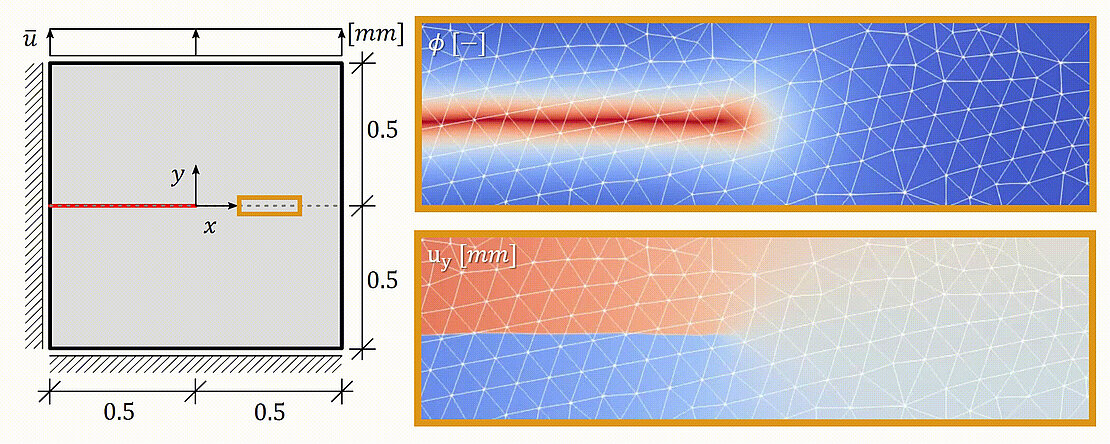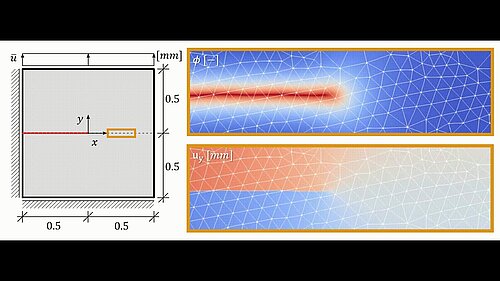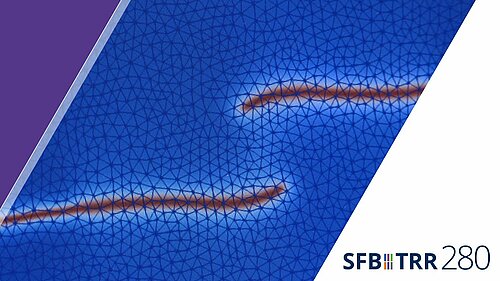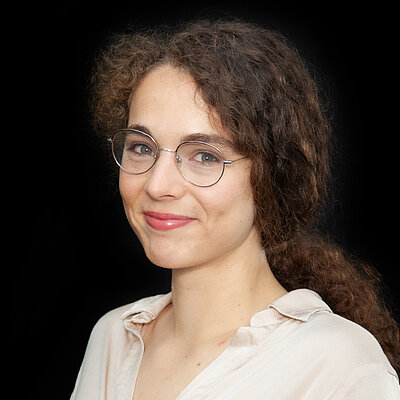Multiscale method for the simulation of the resilience and the fracture behaviour of heterogeneous structures
The aim of this project is to simulatively predict the behavior of thin-walled carbon-reinforced concrete structures under different load combinations and to ensure their sufficient robustness. Focus is the investigation of cracks in concrete at the mesoscale, including their initiation, propagation, branching and coalescence, and how these affect the macroscale behavior. These phenomena can result in complex crack patterns which discrete reproduction within the finite element (FE) method is difficult. Therefore, the phase-field method is applied, in which cracks are represented in a smeared manner. However, the accurate representation of the phase field and the high displacement gradients across the crack requires very fine FE-meshes, which leads to a considerable computational effort. For this reason, the extended phase-field method (XPFM) is developed within the scope of this project. By transforming the phase-field approach and enriching the displacement field, significantly coarser meshes can be used with the XPFM and thus the computational effort can be reduced.
In order to also capture the macroscopic behavior, efficient numerical multiscale methods are required, with which the inhomogeneous and both materially and geometrically non-linear behavior can be taken into account. Therefore, the multiscale projection method suitable for the localisation effects that occur is extended to account for heterogeneities and cracks in shell-like structures with finite deformations.
The combination of the multiscale projection method with the XPFM for three-dimensional elements enables a realistic and locking-free representation of the macroscopic structural behavior with moderate numerical effort. Thus, the resilience of carbon-reinforced concrete structures designed with the strategies developed in CRC/Transregio 280 can be reliably evaluated against different combined external loads.
Within the framework of C05, the seed fund project "Simulation of the fatigue behavior of carbon-reinforced concrete components under changing cyclic loads" (1st round 2022) was carried out. Furthermore, in the seed fund project "Numerical modelling and experimental validation of fibre pull-out behavior in carbon-reinforced concrete" (2nd round 2022), methods were developed to investigate fiber pull-out numerically.



Scientists
![Prof. Dr.-Ing. Stefan Löhnert [Translate to English:] Stefan Löhnert](/fileadmin/_processed_/4/6/csm_Loenert_Quadratisch_246a6abd57.jpg)
D-01062 Dresden (Germany)

D-01062 Dresden (Germany)
Cooperations
Publikationen | Publications
Betz, P.; Curosu, V.; Loehnert, S.; Marx, S.; Curbach, M. (2023) Classification of Multiaxial Behaviour of Fine-Grained Concrete for the Calibration of a Microplane Plasticity Model in: Buildings 13, issue 11 (Spec. Issue Research on the Performance of Non-metallic Reinforced Concrete), 2704 – DOI: https://doi.org/10.3390/buildings13112704
Curosu, V.; Kikis, G.; Krüger, C.; Liebold, F.; Macek, D.; Mester, L.; Platen, J.; Ritzert, S.; Stüttgen, S.; Kaliske, M.; Klinkel, S.; Loehnert, S.; Maas, H.-G.; Reese, S.; Robertz, D. (2023) Ansätze für numerische Methoden zur Inspiration, Analyse und Bewertung neuartiger Carbonbetonstrukturen in: Bauingenieur 98, issue 11, p. 368–377 – DOI: 10.37544/0005-6650-2023-11-56
Curoșu, V.; Krüger, C.; Loehnert, S. (2024) An Enriched Phase-Field Method (XPFM) for the Efficient Simulation of Fracture Processes in: Coombs, W. M. [ed.] Proc. of the 2024 UK Association for Computational Mechanics Conference, 10.–14.02.2024 in Durham (UK), Gistrup: River Publ., p. 197–200 – DOI: 10.62512/conf.ukacm2024.043
Krüger, C.; Curosu, V.; Loehnert, S. (2024) An extended phase‐field approach for the efficient simulation of fatigue fracture processes in: International Journal for Numerical Methods in Engineering (online first) – DOI: https://doi.org/10.1002/nme.7422
Loehnert, S.; Krüger, C.; Klempt, V.; Munk, L. (2023) An enriched phase-field method for the efficient simulation of fracture processes in: Computational Mechanics 71, issue 5, p. 1015–1039 – DOI: 10.1007/s00466-023-02285-z
Marquis, E.; Utech, T.; Klempt, V.; Scheffler, Chr.; Loehnert, S. (2023) Computational Modeling and Experimental Investigation of a Single-Fiber-Pull-Out Test with a Bio-Inspired Carbon Fiber-Matrix Interphase in: Ilki, A.; Çavunt, D.; Çavunt, Y. S. [eds.] Building for the Future: Durable, Sustainable, Resilient – Proc. of fib Symposium 2023, 05.–07.06.2023 in Istanbul (Turkey), publ. in: Lecture Notes in Civil Engineering 350, Cham: Springer, p. 1252–1261 – DOI: 10.1007/978-3-031-32511-3_128
Mester, L.; Klempt, V.; Wagner, F.; Scheerer, S.; Klarmann, S.; Vakaliuk, I.; Curbach, M.; Maas, H.-G.; Löhnert, S.; Klinkel, S. (2023) A Comparison of Multiscale Methods for the Modelling of Carbon-Reinforced Concrete Structures in: Ilki, A.; Çavunt, D.; Çavunt, Y. S. [eds.] Building for the Future: Durable, Sustainable, Resilient – Proc. of fib Symposium 2023, 05.–07.06.2023 in Istanbul (Turkey), publ. in: Lecture Notes in Civil Engineering 350, Cham: Springer, p. 1418–1427 – DOI: 10.1007/978-3-031-32511-3_145
Vakaliuk, I.; Platen, J.; Klempt, V.; Scheerer, S.; Curbach, M.; Kaliske, M.; Löhnert, S. (2022) Development of load-bearing shell-type TRC structures – initial numerical analysis in: Stokkeland, S.; Braarud, H. C. [eds.] Concrete Innovation for Sustainability – Proc. for the 6th fib International Congress 2022, 12.–16.06.2022 in Oslo (Norway), Oslo: Novus Press, p. 1799–1808.



